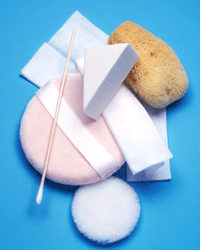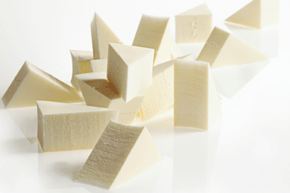Sponges, like brushes, are a highly varied group of tools. Puffs, on the other hand, are a lot more straightforward.
A puff is a soft, pancake-shape applicator. Size and material can vary. Puffs run up to about 4 inches in diameter, come in similarly soft, light textures like velour and microfiber, and are typically synthetic. Polypropylene is a common material used in puffs.
We'll get to their purpose in a moment; first, those sponges. This is a group of applicators that takes some delving into. Sponges vary by size, shape, texture, material and lifetime, and the ones you see in pretty much any makeup aisle include:
Flat (and usually egg-shaped) -- This is often considered a multipurpose sponge, a few inches long and no more than a half-inch deep, with either a flat or a curved edge.
Wedge -- This triangular or nearly triangular sponge has multiple flat sides and edges. Wedges are typically smaller overall than flat sponges, but they are considerably deeper.
Rounded -- While wedges are deep, and flats often have rounded edges, there are sponges that combine those traits into a single tool. It may look like a bulb or teardrop, with one large, spherical end that tapers down to a point, or it may be more elliptical. A length of 3 to 4 inches is typical.
Swab -- A sponge swab looks a lot like a cotton swab. It may be single- or double-tipped.
There are other distinctions in sponges, most notably cell type, natural vs. synthetic and lifetime.
Lifetime -- These tools come in both disposable and reusable forms, which is purely a matter of preference. If you go reusable, though, cleaning with soap and hot water after each use is essential.
Natural vs. Synthetic -- Unlike with brushes, the natural vs. synthetic choice is more personal and less about quality or use. Synthetic fibers may be softer than natural ones, but some people just prefer organics. The larger issue here is the presence or absence of latex, which can cause allergic reactions in some people.
Cell-type -- This is about texture. Sponges can be open-cell, kind of like a kitchen sponge, or closed-cell. In a closed-cell sponge, you can't really see the holes. The surface is far more dense, stiff and smooth. You may also see some multi-purpose sponges that fall somewhere in between, with very tiny holes that mimic the texture of closed cells but have a bit more give.
Identifying applicators is the first step in figuring out what you need and what you don't. Now, let's get practical: You've got your cover-up stick in one hand, your foundation in the other, and your setting powder waiting in the wings. Which tools are you going to use?


